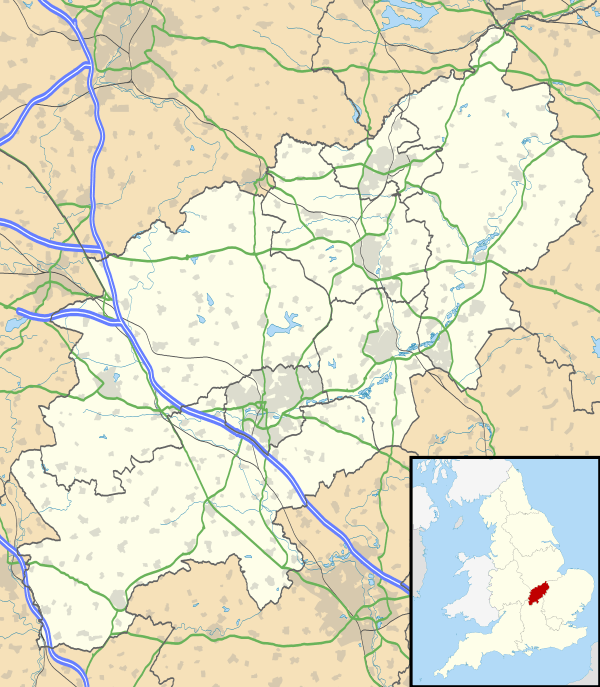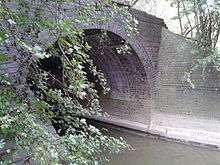Barton Seagrave
| Barton Seagrave | |
 St Botolph's parish church |
|
 Barton Seagrave |
|
| Population | 4,418 (2011 Census)[1] |
|---|---|
| OS grid reference | SP890765 |
| – London | 81 miles (130 km) |
| District | Kettering |
| Shire county | Northamptonshire |
| Region | East Midlands |
| Country | England |
| Sovereign state | United Kingdom |
| Post town | Kettering |
| Postcode district | NN15 |
| Dialling code | 01536 |
| Police | Northamptonshire |
| Fire | Northamptonshire |
| Ambulance | East Midlands |
| EU Parliament | East Midlands |
| UK Parliament | Kettering |
|
|
Coordinates: 52°22′45″N 0°41′38″W / 52.3792°N 0.6939°W
Barton Seagrave is a village and civil parish in the Kettering borough of Northamptonshire, England. The village is a suburb of Kettering, about 1.5 miles (2.4 km) south-east of the town centre. The older part of the village is known for its Norman Church and attractive buildings.
Demographics
The 2011 Census recorded a parish population of 4,418 in 1,843 homes.[1]
Transport
The A6 road linking London and Leicester runs through the top of the village and joins to the A14 road just outside the village. The A14 joins to the M1 motorway at junction 19 (Catthorpe Interchange) offering easy access to Huntingdon, Felixstowe and London.
The Midland Main Line runs to the west of the village, partly along the edge of the River Ise. The nearest station is Kettering railway station, which opened in 1857 and is maintained by East Midlands Trains,[2] who run services to London, Sheffield, Corby and Derby.[3]
The village used to be connected with Cambridge by rail via the Kettering, Thrapston and Huntingdon Railway, until this was closed in 1961 due to the Beeching cuts.[4] Part of the route of the Branch can still be viewed today and is in use as a footpath.[5]

Governance
Barton Seagrave has a Parish Council and forms the Barton ward of Kettering Borough Council. It is in the Wicksteed division of Northamptonshire County Council.
Facilities
The village has a wide range of amenities including a convenience store on Gotch Road, a full-service Post Office in St Botolph's Road and a petrol station beside the A6 on the outermost limits of the village. There is also a Community Centre in Castle Way, along with the Masque Theatre.
The village has one pub, The Stirrup Cup, in Woodlands Avenue. This serves real ales and has a regular quiz night.[6]
Environment
The village is home to the Castle Fields Wildlife Trust site.[7] This is managed by the Wicksteed Trust and is a haven for plants, including Meadowsweet.[7] A footpath runs through the reserve to the arboretum at Wicksteed Park and sheep graze in the reserve during the summer.
There is also a pocket park, Wallis Spinney, a strip of woodland which lies within the Ise Valley, south-east of the church, with access off Bevoir Drive. The Spinney is cut into three areas by a road and a tarmac footpath and is the site of ancient woodland of mainly ash and field maple, which was neglected, but is now being cared for. The site now has accessible paths and information signs to welcome visitors, but is difficult to access from Castle Way due to the fence built by Ms Hearne on behalf of the Latimer Community Arts College.[8] It is named after a local farmer, Samuel Wallis, and was once owned by Wicksteed Park. It is thought that most trees were planted in the 17th century, although it is probable that woodland was present prior to this. There is evidence of coppicing, hedge-laying and a boundary ditch, possibly from a medieval field system.
Education
The village has two excellent schools, The Latimer Arts College[9] and Barton Seagrave Primary School. Both are operated by Northamptonshire County Council and are located next to each other at the top of Castle Way.[10] Combined, they offer a full education from reception through to A-Levels.
Expansion proposals
The village is within walking distance of Wicksteed Park which forms a welcome green belt between the village and Kettering. Encroaching the village are currently new warehouse developments along the A14 built on former agricultural land. The A6 road forms the other major village border.
A controversial plan to build 450 homes at Barton Seagrave was approved in June 2009.[11] Kettering Council's planning committee granted developers Redrow Homes outline planning permission to build on land off Polwell Lane in the village close to Wicksteed Park. More than 100 people opposed to the development attended the meeting. The decision was met with protests from residents, some who threw agenda documents towards councillors and continued to argue after the decision. An action group[12] was set up to fight the proposals but was ultimately unsuccessful. Building work began in 2013.[13]
Notable buildings
Church
The village has one of the oldest churches in Kettering. It is the Norman Church of England parish church of Saint Botolph, parts of which date from 1120-1130 AD.[14][15] Much of the rest is 13th century. There are memorials to Jane Floyde (died 1616) wife of Hugh Floyde, rector, who is depicted at a prayer desk attended by five children,[16] and also to three John Bridges (died 1712), the county historian (died 1724) and another (died 1741). The Bridges family lived at Barton Seagrave Hall.[15] Barton Seagrave War Memorial is in the church grounds.
Rectory
This building was built around 1700, although the south side was rebuilt in 1806.[15] It is currently in use as an offshoot of the church.
Castle
South-west of the village centre is the site of Barton Seagrave Castle. This was built in the early part of the 14th century by Nicholas Segrave the younger, but became ruined after 1433.[16] It was surrounded by a moat, and another moat lies to the north of the castle site. These can still be seen today.
Barton Seagrave Hall and Wicksteed Park
Originally built in 1550 by the Humphrey family,[17] it was bought in 1665 by John Bridges (1642–1712) of Warwickshire, son of the parliamentarian Major Bridges of Alcester. John was Sheriff of Northampton in 1675. After his John died, his son John Bridges (1666–1742) inherited the house. He was an antiquarian and a Fellow of the Royal Society. The house passed to his brother, William (1668–1741) who carried out more renovations started by his father – the date 1725 being on the lead rain-water heads.[16] However, he fell into debt and was forced to mortgage the house in 1733. Later that century the house was owned by the Wilcox family then Richard Tibbits whose son was responsible for modernising the house further. Lady Mary Isabella Hood-Tibbits lived at the house for many years until her death in 1904 when the house came up for sale and was bought by Charles Wicksteed. He laid out Wicksteed Park[18] within its boundaries. On his death, the house and the park passed to the Wicksteed Village Trust. It was a hotel for a while, then a nursing home for the elderly. For a while it housed part of the NHS on the ground floor, before becoming an arts centre. The first floor and stables accommodated the artists and designers. It is now home to the Vines Restaurant and the Barton Hall Hotel.[19] It can also be hired out for weddings and other events.
The house is of two stories, of limestone and roofed with Collyweston slates.[16] The main front faces south and has projecting end-wings with plain gables and a middle gabled porch of two stories with classic doorway. A wing at the east end containing a number of small rooms appears to be older than the rest of the building.[16] The Orangery is a grade I Listed Building.[17]
Notable residents
Rear Admiral Horace Hood once lived in Barton Hall[20] as a member of the Hood Family. He was killed on the HMS Invincible during the Battle of Jutland[21] in May 1916, and his name is on the Barton Seagrave War Memorial.
The soprano singer Elizabeth Harwood was born in the village on 27 May 1938, but moved to Yorkshire at an early age.
Other natives of the village include topographer John Bridges and his brother, Charles, a painter.
References
- 1 2 "Area: Barton Seagrave (Parish): Key Figures for 2011 Census: Key Statistics". Neighbourhood Statistics. Office for National Statistics. Retrieved 21 December 2013.
- ↑ "National Rail Enquiries - Station facilities for Kettering". nationalrail.co.uk. Retrieved 21 March 2015.
- ↑ http://www.eastmidlandstrains.co.uk/Global/Dec_13_Timetables/TT1W%20CD%20Feb%20to%20May%202014%20for%20Web.pdf
- ↑ "Railways to Cambridge: A History". ivimey.org. Retrieved 21 March 2015.
- ↑ "A cattle access tunnel under the old Kettering to Huntingdon and Cambridge railway". Flickr. Retrieved 21 March 2015.
- ↑ "Stirrup Cup". beerintheevening.com. Retrieved 21 March 2015.
- 1 2 "Wicksteed Park". wildlifebcn.org. Retrieved 21 March 2015.
- ↑ "Log into Facebook - Facebook". Facebook. Retrieved 21 March 2015.
- ↑ "The Latimer Arts College". latimer.org.uk. Retrieved 21 March 2015.
- ↑ "The Latimer Arts College". latimer.org.uk. Retrieved 21 March 2015.
- ↑ "Controversial plans to build homes at Barton Seagrave approved". northantset.co.uk. Retrieved 21 March 2015.
- ↑ Barton Action Group Archived 5 September 2011 at the Wayback Machine.
- ↑ "Castle Fields". redrow.co.uk. Retrieved 21 March 2015.
- ↑ "St Botolph's Parish Church website - includes plan and history, accessed 29 March 2010". st-botolphs.org.uk. Retrieved 21 March 2015.
- 1 2 3 Pevsner, Nikolaus; Cherry, Bridget (1973) [1961]. Northamptonshire. The Buildings of England (Revised ed.). London and New Haven: Yale University Press. pp. 103–5. ISBN 978-0-300-09632-3.
- 1 2 3 4 5 "Parishes: Barton Seagrave". british-history.ac.uk. Retrieved 21 March 2015.
- 1 2 Barton Seagrave Hall - website, accessed 29 March 2010 Archived 11 September 2010 at the Wayback Machine.
- ↑ "Wicksteed Park - UK Kids Theme Park Park - Family Days Out Northamptonshire". wicksteedpark.co.uk. Retrieved 21 March 2015.
- ↑ Barton Hall. "Vines Brasserie : Barton Hall : Hotel, Spa and Restaurant". bartonhall.com. Retrieved 21 March 2015.
- ↑ "The Plantagenet Roll of the Blood Royal". google.co.uk. p. 142.
- ↑ "Main Template". bedfordregiment.org.uk. Retrieved 21 March 2015.
External links
| Wikimedia Commons has media related to Barton Seagrave. |
- Barton [Seagrave] in the Domesday Book